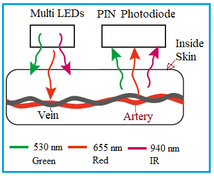10 Applications of Photodiodes: Working, Types, Advantages, and Limitations
Advertisement
A photodiode is a semiconductor device that converts light into an electrical current when exposed to photons. It operates in reverse bias mode, meaning that when a voltage is applied across it (with the anode positive and cathode negative), it generates a current in response to incident light.
How Photodiodes Work
Let’s understand the photodiode structure and its working operation:
- Photodiodes are typically made from semiconductor materials such as silicon or gallium arsenide.
- Similar to a regular diode, a photodiode has a PN junction. When light photons strike the PN junction, electron-hole pairs are generated due to the energy from the photons.
- The photons excite electrons across the PN junction, creating a flow of current proportional to the intensity of the incident light.
- Photodiodes are operated in reverse bias mode to increase the width of the depletion region, allowing more incident photons to generate electron-hole pairs and thus increasing sensitivity.
Types of Photodiodes
The following are the common types of photodiodes:
- PN Photodiode: The most common type, which operates similarly to a regular diode.
- Avalanche Photodiode (APD): Operates under high reverse bias conditions, leading to internal multiplication of carriers (avalanche effect), resulting in higher sensitivity and faster response times.
- PIN Photodiode: Has an intrinsic layer between the P and N regions, which reduces capacitance and increases response speed, making it suitable for high-speed applications.

The figure depicts a photodiode symbol and one such device from OSRAM.
Photodiode Applications
Here are 10 applications of photodiodes in various fields:
- Fiber Optic Communication: Photodiodes are used as receivers in fiber optic communication, converting optical signals into electrical signals carrying data. This data can then be processed by electronic devices.
- Photometry: They are used in light meters and exposure meters in photography and cinematography to measure the intensity of light.
- Spectrometry: They are used in spectroscopy instruments for the measurement of spectral characteristics of light emitted or absorbed by substances.
- Remote Sensing: Used in remote sensing devices in satellites to detect and measure light from distant objects or Earth’s surface, providing data for climate monitoring, geology, and agriculture.
- Medical Devices: Used in medical devices such as pulse oximeters to measure blood oxygen levels (i.e., SpO2) by detecting light absorption through tissue (typically red and infrared wavelengths).
- Barcode Scanners: They are used in barcode scanners or readers to detect variations in reflected light intensity from barcode patterns. They find applications in retail, inventory management, and logistics.
- Camera Autofocus Systems: Used in cameras for auto-focus systems. Here, photodiodes measure contrast or phase differences in light to adjust focus automatically, helping to enhance user experience by ensuring sharp and clear images.
- Automatic Headlight Switching: Used in vehicles for automatic switching of headlights between day and night modes based on ambient light levels.
- Industrial and Scientific Applications:
- X-ray Detectors and Radiation Dosimeters: Used to detect and measure ionizing radiation.
- Smoke Detectors and Flame Sensors: Used to detect the presence of smoke or flames based on light absorption or emission characteristics.
- Solar Cells: They are used in solar cells and photovoltaic arrays to convert sunlight directly into electrical power.
Advantages of Photodiodes
The following are the benefits or advantages of photodiodes:
- High Sensitivity: They can detect very low levels of light, making them suitable for applications requiring precise detection.
- Fast Response: They can respond quickly to changes in light intensity, crucial for high-speed communication and detection systems.
- Compact and Durable: Due to their semiconductor-based construction, they are compact in size, durable, and reliable.
Limitations of Photodiodes
The following are the drawbacks or limitations of photodiodes:
- Wavelength Sensitivity: Sensitivity is typically limited to specific wavelengths of light depending on the material used (e.g., silicon for visible and near-infrared).
- Temperature Dependence: Performance can be affected by temperature variations, requiring temperature compensation in some applications.
Conclusion
Photodiodes play a crucial role in advancing technology across various sectors, from telecommunications and healthcare to environmental monitoring and renewable energy. Their versatility in converting light into electrical signals enables a wide range of applications that enhance efficiency, safety, and functionality in everyday life and industry.
Advertisement
 RF
RF







